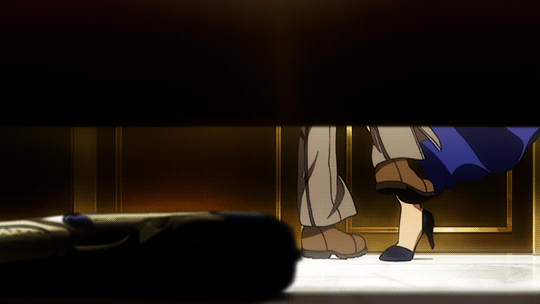#CANAAN
Explore tagged Tumblr posts
Text

Anat the Canaanite goddess of sexual love, war, and hunting. Progenitress of heroes, lady of Palestine.
Info on each sketch below:
Top right: Anat is shown here in a man's war kilt and her hair pulled up, a nod to the Anat statue head found in Gaza. This is after Baal Hadad's 'death', with her cheeks gouged by grief and face painted to resemble a man's beard. This beard imitation combined with her topless clothing and the horned headdress she wears is to evoke a sense of Baal having risen from the dead to claim revenge.
Bottom Right: An exploration of her musculature, with a focus on the markings on her hips and stomach. Drawn from female Canaanite fertility idols that show similar markings with a lot of emphasis on the navel/bellybutton.
Bottom Left: Anat at the feast of Baal's new palace. She wears expensive, imported Egyptian linens. Her hair is braided, eyelids darkened with kohl, and hands darkened with henna.
Center: Anat's fullbody with lots of influence from historical Palestinian dress. She is shown with a vulture because Aqhat, killed at her order, was eaten by vultures and because Anat is often shown with wing imagery.
2K notes
·
View notes
Text
Some notes on the name Palestine
TL;DR: Palestine is a colonialist name from a group trying to deny an indigenous group's indigenousness as part of a genocidal campaign. It may have acquired other meanings, but the etymology is still linked tightly to that, and it still carries that past with it. Anyone who considers themselves pro-indigenous should not use the term.
Let's rewind. The word Palestine is related to "Philistine"; indeed, it comes from them. So who were they?
In short, a bunch of Greeks who created a syncretic culture in what is now, roughly, Gaza. They mixed with the native people, called Canaanites. (We don't know what they called themselves - Philistine itself derives from a Biblical term.)
They vanished pretty fast, and then, a while later, the Romans came.
The indigenous population rebelled too much, so they embarked on a campaign of genocide. They killed people, of course. But they also raped enough women that Judaism is matrilineal. They sold people as slaves, barred them from their holy city and capital, Jerusalem (which they renamed). They destroyed the Jewish holy temple, the Second Temple (there is now a mosque on top of it).
And then they tried to deny that the indigenous population was, in fact, indigenous. They renamed the region Syria Palestina. Why? Because Philistines weren't around anymore. They could pretend there weren't any indigenous people to displace.
Over time, that word, Palestina, moved. It moved to Arabic, where it became Filastin. It moved to English, where it became Palestine.
But the indigenous name for the region (except, arguably, for Gaza, give or take) has never been Palestine.
We don't know what the Neanderthals, the first group there, called it.
But we know what many of the indigenous people call it. Eretz Yisrael. Or, in English, the Land of Israel.
("But wait!" you say. "You just said that in Arabic it was Filastin. Palestinians are native and speak Arabic!"
But they didn't speak Arabic back then. Arabic came with the Arab conquerers (who Palestinians aren't super related to, FYI). Arabs spread vastly during the Islamic conquests, but before that, they were primarily a desert people, whose homeland corresponded to roughly Saudi Arabia, although it extended to places like Syria and Oman. There are majority-Arab countries and places today that range from Morocco to Mauritania, Sudan to Iraq, Egypt to (parts of) Iran. Arabs are not indigenous to any of those places, and neither is Arabic.)
You may not support the Roman genocide. I hope you don't. But you are still using a term European colonialists used to erase indigenous identity as they genocided them, and it still carries that baggage.
(If you refuse to call the region Israel, Canaan is also a fine term - although it may get you some weird looks.)
#the official languages of canaan are french and english#but in the province of nunavut inuit is the most spoken language#jumblr#jewblr#jewish#judaism#jewish tumblr#israel#fuck the romans#people still believe their propaganda 2000 fucking years later#2000 FUCKING YEARS#...anyway#palestine#indigenous#genocide#terminology#terminology matters#words matter#canaan#(not to be confused with canada as tumblr's autorecommendation suggests)#like seriously don't confuse it with canada
280 notes
·
View notes
Text







Source
#palestinians#jews#israel#palestine#canaan#canaanites#khazars#arabs#arab conquest#colonizers#jesus was a palestinian
352 notes
·
View notes
Text
A few days ago, in my quest to fight the antisemitism that lifted its head around the world following the massacre of October 7th, I stumbled upon a clip from a UN assembly where the speaker asked a simple question-
Dear Arab world, where are your Jews?
A lot of people think that Israeli roots come from Europe exclusively. But in fact, Jewish people were hunted in all corners of this world. In Europe, of course, but also in Asia, Africa and other places all over the planet.
My grandma is an Iraqi Jew. Iraqi Jewish community is one of the oldest Jewish communities in the world, being the direct descendants of the Babylonian exile Jews, so ancient it is an exile mentioned in the Bible.
Recent studies, in which DNA retrieved from canaanite burial lands was compared to current populations in the area of ancient Canaan, has found that Iraqi Jews share the highest similarity to canaanite DNA out of all Jewish communities, more than 50% of the DNA on average.
All the beautiful, peaceful Jewish communities of the Arab world were wiped out in the blink of an eye.
The Arabic world has never treated their Jewish communities as equal citizens, oftentimes robbing them of any rights and performing violent acts of genocide against them (check 'Farhud' on Google).
But their voice was silenced once they fled to Israel.
So I decided to recap my grandma's story in the comments of the clip:
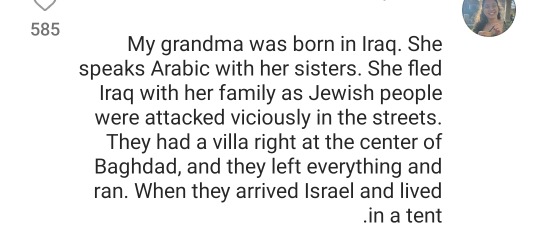
Soon after, many Jewish people with Arabic, or 'Mizrahi' heritage, shared their stories as well:



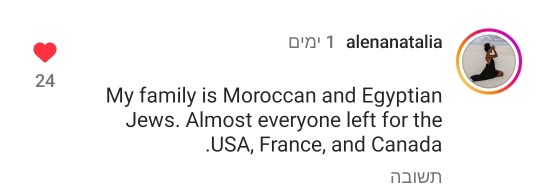


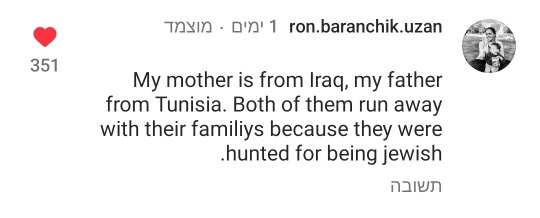
Jewish people all over the planet were driven out of their homes, ethnically cleansed by their neighbors, rulers, and governments.
We are still not welcome in most of the countries of the Arab world. Unable to see glimpses of our history.
My grandma still wishes she could see the house she grew up in. Holding the memories, but unable to set foot in that land, because she would be executed.
Nevertheless, she's not a refugee. She might've fled to Israel, but in Israel, her family got equal rights as citizens, and she built a house on a land she now calls her home.
Don't erase my grandma's story. Don't erase the Jewish ethnic cleansing that brought her to seek a safe haven in Israel.
Israel is a home for more than half of the Jewish people on this planet. Out of the ~8,000,000 Jews who live in Israel, there are about ~2,500,000 Jews of Mizrahi heritage.
And as Golda Meir once said: "our secret weapon is that we have nowhere else to go."
#omi talks#jewish#Iraqi Jews#jumblr#israel#mizrahi jews#canaan#I hate the fact that Israel only trends on this hellsite when people wish its destruction#it's never two state solution it's always 'from the river to the sea'#that's just messed up
2K notes
·
View notes
Video
Deer in the morning mist - Canaan Valley, West Virginia. by Kevin B. Moore
#audrey#autumn#canaan#deer#fall#fog#fogbow#foliage#landscape#lodge#mist#nature#overlook#rural#sunrise#sunset#valley#valley. trees#weather#west virginia#wildlife#wv#morning#flickr
189 notes
·
View notes
Text
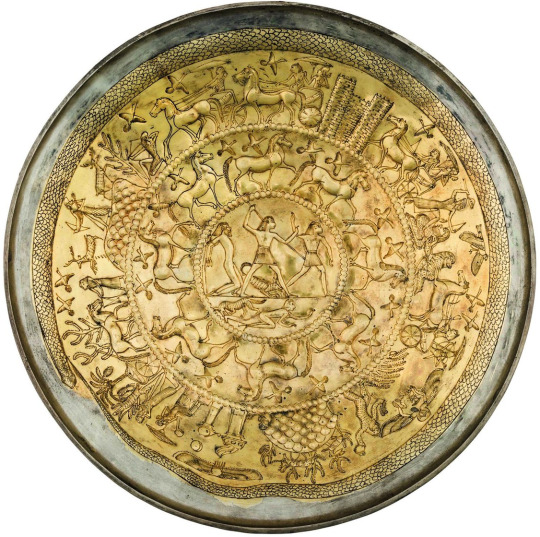

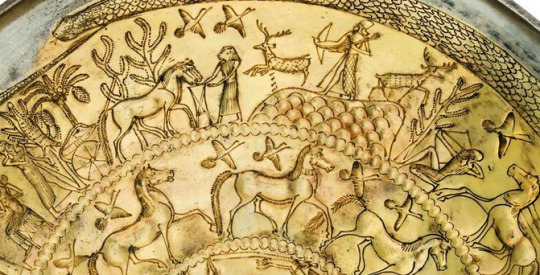

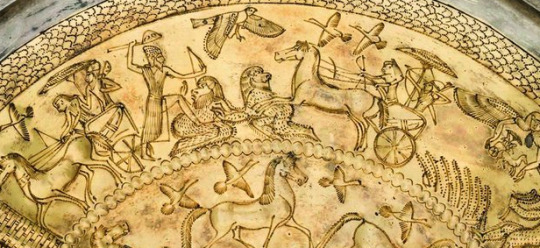
Phoenician Bowl with encircling Serpent Bernardini Tomb (Palestrina, Italy) c. 700 BCE The National Etruscan Museum of Villa Giulia Rome, Italy
#cyprus#rome#italy#egypt#egyptian gods#canaan#canaanite gods#phoenicia#phoenician gods#aram#aramean gods#syria#syrian gods#levantine gods#mesopotamia#mesopotamian gods#pagan gods#polytheism#archeology#magic#witchcraft#witchblr#paganblr#occult#uroboros#ouroboros#warfare#hunting#soldiers#birds
1K notes
·
View notes
Text








Asherah aesthetic 🌱🌾🌤
#asherah#yahwism#yahweh#yahwist#canaan#isrealites#canaanites#occult#occultist#asherahxyahweh#asherahgoddess#nature#witchcraft#witch#ancientreligion#tanakh#bible#goddess
117 notes
·
View notes
Photo

Mount Sinai
Mount Sinai (Hebrew: Har Sinay, Arabic: Jabal Musa, "mountain of Moses") is a holy site for the three Abrahamic religions: Judaism, Islam, and Christianity. It has traditionally been located in the center of the Sinai Peninsula, between Africa and the Middle East. A 2200-meter peak, it tops a region known as the Arabian-Nubian Shield, consisting of crystalline and granite rock formations with volcanic elements.
Name & Location
The origin of the name remains open to debate. Theories consider the root of sin from the Mesopotamian moon god Sin, who was also associated with the Egyptian moon god Thoth. Rabbinical texts cited the root of seneh, where, in two cases, it referred to the site of the "burning bush."
The earliest history of this region was its importance for the location and mining of various metals: gold, silver, copper, zinc, tin, and lead. Pharaonic Egypt had numerous mines in the region as well as a string of defensive fortresses along this northeastern border. In the biblical traditions of King Solomon (900s BCE), his wealth was accounted for because of 'Solomon's mines' in the area. Ancient mining centers have been excavated on the peninsula.
Continue reading...
36 notes
·
View notes
Text
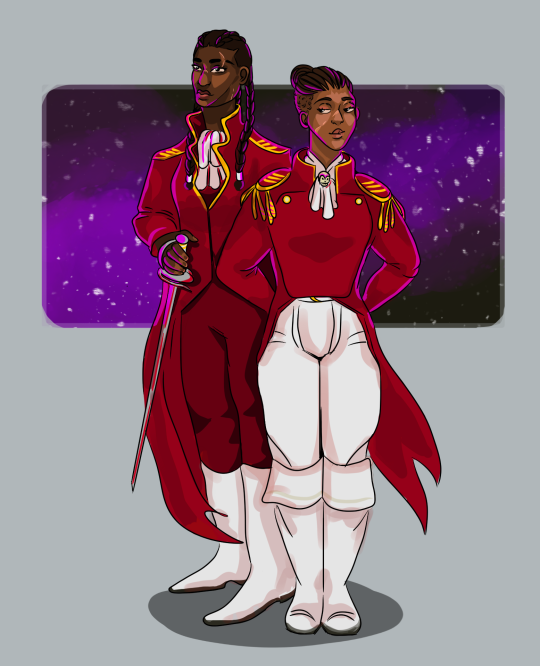
Judith and Marta repping the Cohort first and foremost
#judith deuteros#marta dyas#tlt fanart#the locked tomb#gideon the ninth#canaan#tlt#fan art#im kinda sorry for Judith since I learned she was not only rejected by her cavalier but grew up thinking that was absolutely wrong#but she's also such a lawful rule-follower and so self-important sometimes!#i have only read Harrow the Ninth so far that's where I got these opinions lol
169 notes
·
View notes
Text

[CANAAN] Anat beautifying herself for the festivities at Baal's new palace
#anat#canaan#canaanite myth#canaanite god#goddess anat#my art#doodl#look ok i know im borrowing some hathor iconography but look. listen. ok.#red dress like this chosen bc of that one egyptian popular image of her on the throne w axe and spear#horns bc duh#it makes sense to me!
159 notes
·
View notes
Text

I am continuing my current Xeno-train of thought with learning another character, this time it's my favorite male character, chaos.
I feel like I got him down pat with his Episode I look because it's just absolutely perfect, but everything else I was experimenting more with his range in expression as the later games fiddled around with that... As in, I will not forgive what they did to him in Episode II. :(
The ahoge is the last remaining source of his powers (and feelings).
Otherwise I mean for his face to look the face with each design.
#see what happened is that chaos' ahoges got lost in The Incident#(read as: when kos-mos had to save everyone from impacting with second miltia's atmosphere)#so now he is buffering throughout that entire game#such is the way I choose to interpret the design choices#(except that outfit. I can't say I like the color. *sob* )#why did they do him like that#anywho I may have made him look a bit bappy with my initial takes but#that could also be due to me focusing on episode i's proportions more#doodle-daas#xenosaga#chaos#jin uzuki#canaan#(that's supposed to be him you can't tell eh?)#I'm also not sure how much you can tell but chaos' design is a decent portion of my inspiration for alto's design#what with the undergarment accompanied with a minimum attire that also completes his overall body shape
39 notes
·
View notes
Text


Canaan ; Canaan ☆ Good Smile Company
#canaan#canaan figure#good smile company#gsc#anime#anime figure#figure#figure collecting#anime figurine#figurine#scale figure#anime collecting#myfigurecollection#manga
70 notes
·
View notes
Text




@giftober 2024: DAY 11 - ORANGE
The rest of the day was quite easy. I did all the jobs on my list And enjoyed them and had some time over. I love you. I'm glad I exist.
#Canaan#Maria Oosawa#animeedit#animangaladies#fyanimegifs#animationedit#giftober2024#poem is the orange by wendy cope
38 notes
·
View notes
Note
Moses committed a genocide like, right after freeing the slaves from Egypt and took slaves from people he conquered according to his own story. Jesus said slaves should be kind to their masters so they both end up in heaven, every prophet is fucked up
I’m pretty sure Buddhists have committed genocide at least at one point.
I can point to any number of Christian preachers preaching to kill gay people, they helped elect our latest president here in America
Heck, “when have Christians killed people” the crusades!? The Spanish Inquisition!? The pedophiles the Catholic Church continues to protect to this day?
The way I see it, once one religion is in power it tends to go after every other religion.
And Christians have committed plenty of terror attacks.
Moses never even entered Canaan. But don't let facts get in the way of your false narrative.
#Moses#israel#secular-jew#jewish#judaism#israeli#jerusalem#diaspora#secular jew#secularjew#islam#Bible#Torah#promised land#Canaan
22 notes
·
View notes




